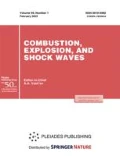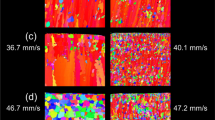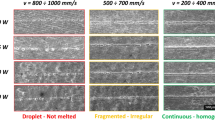Abstract
Laws of self-propagating high-temperature synthesis in 3Ti + 2BN reactive mixtures after preliminary mechanical activation in a planetary ball mill are studied. A discontinuity caused by specific features of the dynamics of formation of mechanocomposites is observed on the plots of the burning rate and temperature versus time. Regimes of preliminary activation are determined, which ensure the solid-phase combustion regime. Results of x-ray diffraction phase analysis and electron microscopy of combustion products and initial mixtures for different times of mechanical activation are presented.
Similar content being viewed by others
References
G. V. Samsonov, Nitrides [in Russian], Naukova Dumka, Kiev (1969).
Z. A. Munir, “Synthesis and densification of nanomaterials by mechanical and field activation,” J. Mater. Synth. Process., 8, Nos. 3/4, 189–196 (2000).
I. Gotman, N. A. Travitzky, and E. Y. Gutmanas, “Dense in situ TiB2/TiN and TiB2/TiC ceramic matrix composites: Reactive synthesis and properties,” Mater. Sci. Eng. A, 244,Issue 1, 127–137 (1998).
M. Shapiro, I. Gotman, and V. Dudko, “Modeling of thermal explosion in constrained dies for B4C-Ti and BN-Ti powder blends,” Europ. Ceram. Soc., 19, 2233–2239 (1999).
Jae-Hyeok Shim, Jung-Soo Byun, and Young Whan Cho, “Mechanochemical synthesis of nanocrystalline TiN/TiB2 composite powder,” Scr. Mater., 47, 493–497 (2002).
Jae-Hyeok Shim, Jung-Soo Byun, and Young Whan Cho, “Influence of stearic acid on mechanochemical reaction between Ti and BN powders,” Alloys Compounds, 365, 149–156 (2004).
C. Suryanarayana, “Mechanical alloying and milling,” Progr. Mater. Sci., 46, 1–184 (2000).
R. Tomoshige, A. Murayma, and T. Matsushita, “Production of TiB2-TiN composites by combustion synthesis and their properties,” J. Amer. Ceram. Soc., 80, No. 3, 761–764 (1997).
A. É. Grigoryan and A. S. Rogachev, “Combustion of titanium and nonmetal nitrides,” Combust., Expl., Shock Waves, 37, No. 2, 168–172 (2001).
M. A. Korchagin, T. F. Grigorieva, B. B. Bokhonov, et al., “Solid-state combustion in mechanically activated SHS systems. I. Effect of activation time on process parameters and combustion product composition,” Combust., Expl., Shock Waves, 39, No. 1, 43–50 (2003).
M. A. Korchagin, T. F. Grigorieva, B. B. Bokhonov, et al., “Solid-state combustion in mechanically activated SHS systems. II. Effect of mechanical activation conditions on process parameters and combustion product composition,” Combust., Expl., Shock Waves, 39, No. 1, 51–58 (2003).
E. A. Levashov, V. V. Kurbatkina, and K. V. Kolesnichenko, “Laws of the influence of preliminary mechanical activation on the reactivity of titanium-based SHS mixtures,” Izv. Vyssh. Uchebn. Zaved., Tsvet. Metallurgiya, No. 6, 61–67 (2000).
M. A. Korchagin and D. V. Dudina, “Application of self-propagating high-temperature synthesis and mechanical activation for obtaining nanocomposites,” Combust., Expl., Shock Waves, 43, No. 2, 176–187 (2007).
M. A. Korchagin, T. F. Grigorieva, A. P. Barinova, and N. Z. Lyakhov, “Solid-phase regime of self-propagating high-temperature synthesis,” Dokl. Ross. Akad. Nauk, 372, No. 1, 40–42 (2000).
M. A. Korchagin and N. Z. Lyakhov, “Self-propagating high-temperature synthesis in mechanically activated compositions,” Khim. Fiz., 27, No. 1, 73–78 (2008).
E. G. Avvakumov, A. R. Potkin, and O. I. Samarin, “Planetary mill,” USSR Author’s Certificate No. 975068, Byul. Izobr. No. 43 (1982).
H. L. Schick, Thermodynamics of Certain Refractory Compounds, Academic Press, New York-London (1966).
A. S. Bolgar and V. F. Litvinenko, Thermodynamic Properties of Nitrides [in Russian], Naukova Dumka, Kiev (1980).
S. S. Batsanov and E. V. Lazareva, “Structural features of shock-compressed BN, based on IR spectroscopy data,” Zh. Strukt. Khim., No. 4, 753–755 (1978).
A. G. Merzhanov, Solid-Flame Combustion [in Russian], ISMAN, Chernogolovka (2000).
E. A. Levashov, A. S. Rogachev, V. I. Yukhvid, and I. P. Borovinskaya, Physical, Chemical, and Technological Fundamentals of Self-Propagating High-Temperature Synthesis [in Russian], BINOM, Moscow (1999).
Author information
Authors and Affiliations
Corresponding author
Additional information
__________
Translated from Fizika Goreniya i Vzryva, Vol. 46, No. 2, pp. 59–67, March–April, 2010.
Rights and permissions
About this article
Cite this article
Korchagin, M.A., Bokhonov, B.B. Combustion of mechanically activated 3Ti + 2BN mixtures. Combust Explos Shock Waves 46, 170–177 (2010). https://doi.org/10.1007/s10573-010-0026-4
Received:
Published:
Issue Date:
DOI: https://doi.org/10.1007/s10573-010-0026-4




